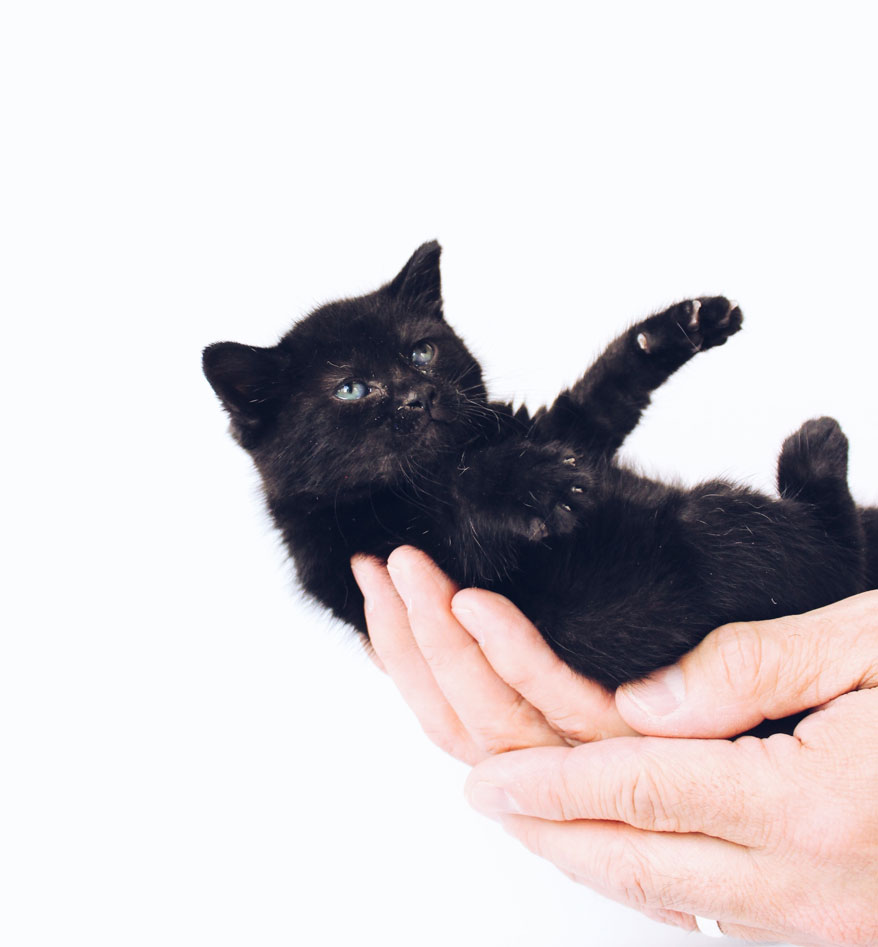Bringing Home a New Kitten

Before your kitten has contact with other cats, it needs to visit the veterinarian to be tested for feline leukemia virus and feline immunodeficiency virus, given a physical examination, tested and treated for parasites, and vaccinated. This will prevent the spread of a disease or parasites to other pets. If you have other pets, talk to your veterinarian about how to introduce your kitten to them.
Kittens receive some immunity (protection against disease) from their mothers at birth and through nursing. Because this immunity slowly wears off, kittens should be vaccinated against various diseases on a schedule, beginning at two to three months of age. Eight weeks is the best time to start vaccines. Ask your veterinarian for details.
Intestinal parasites are common in kittens. Fecal examinations and treatments (dewormings) are usually repeated until two consecutive fecal examinations have negative results. External parasites (fleas, ticks and mites) are treated with products approved for use on kittens.
Kittens should be spayed or neutered by six months of age. This helps to control pet overpopulation and reduces the chance of behavior problems and some medical conditions. Have your kitten microchipped as well when he or she gets neutered or spayed.
Bringing your kitten home

Kittens can leave their mother and littermates after they have been weaned, usually at eight to ten weeks of age. Like human babies, kittens require special care, including veterinary care, feeding and socialization. The best time to bring a kitten home is when you have at least one or two days to focus on helping him adjust to new surroundings.
To transport your new kitten home safely, you’ll need a carrier. Leaving mom is a big deal for your kitten; a carrier will help her feel more secure. Don’t use another pet’s carrier because its smell could be stressful to your kitten. Place a towel in the carrier for warmth and to absorb urine in case of an accident, and be sure to carry an extra towel.
Kitten supplies
- High quality brand-name kitten food with the American Association of Feed Control Officials (AAFCO) statement on the bag or label
- Food and water bowls; ceramic and metal are preferred because some pets are sensitive to plastic
- Cat toys that don’t have small parts or string that can come off and be swallowed
- Cat brush; brush your kitten gently twice weekly
- Cat toothpaste and toothbrush; it’s best to start toothbrushing during kittenhood; aim for at least three times per week
- Breakaway collar and identification tag, and ideally, a microchip placed by your veterinarian as well
- Scratching post and/or pad; when your kitten uses it, reward him with praise and/or a feline treat
- Litterbox
- Litter; low-dust, unscented scoopable litter is best
- Cat carrier
- Cat bed

Before you bring your kitten home, prepare a small room or space that will be her own for the first few days or weeks. Having a smaller area to explore at first will help your kitten get comfortable with her new home. Be sure to secure all electrical and blind cords because they can cause harm to your new kitten. Have all the supplies needed available and ready, such as water and food bowls, kitten food, a litterbox, a scratching post, safe toys, a bed, a breakaway collar and nail trimmers.
Cats don’t like to eat next to the litterbox, so place the litterbox on one side of the room and the food and water dishes on the other. Make sure that your kitten can get in and out of the litterbox without help; it might be necessary to provide a litterbox with low sides. To help your kitten feel secure, make sure that the room has hiding places. If there isn’t furniture to hide beneath, place cardboard boxes on their sides or cut doorways into them. Providing a warm and comfortable bed is essential. You can purchase a pet bed or line a box with something soft; using a sweatshirt that you’ve worn will help your kitten get used to your scent.

When you bring your kitten home, put the carrier in the room you’ve prepared. Open the carrier door, but let your kitten come out when he is ready. After your kitten comes out, leave the carrier in the corner as another hiding place. Each day, scoop out the litterbox and provide fresh food and water.
Your kitten may hide at first, but he will explore when no one is watching, becoming more comfortable with his new home. Your kitten will likely want plenty of attention from you.
After your kitten has been checked by a veterinarian, becomes comfortable in his room and develops a regular routine of eating, drinking and using the litterbox, you can let him venture out into the rest of your house. At this point, you need to make sure that your kitten stays safe and has enough privacy to eat, sleep and use the litterbox. Keep your kitten’s bed, litterbox and food/water dishes in the same place so that he knows where to find them.
Nutrition
Proper nutrition is especially important for kittens because they need two to three times as many calories and nutrients as adult cats. A mother cat’s milk provides everything a kitten needs during the first four weeks of life. Cow’s milk (the kind most likely in your refrigerator) should never be given to kittens or cats because it can give them diarrhea. Most kittens are completely weaned between eight and ten weeks of age. At six to seven weeks of age, kittens should be able to chew dry food. Feed her a high quality, name-brand kitten food with the American Association of Feed Control Officials (AAFCO) statement on the bag or label until she is approximately nine to twelve months old. The AAFCO seal indicates that the diet has been shown to contain the proper nutrition for kittens. Talk with your veterinarian to determine to right type of food to feed your kitten. When your kitten is between three and six months old, feed her three times per day, and once she turns six months old, you can start feeding her twice daily.
Socialization
Cats learn how to socialize with each other from their mother and littermates; therefore, if possible, kittens should remain with their mother and/or littermates until they are about eight to ten weeks old. Kittens that have human contact before they are ten to 12 weeks old are more likely to interact well with people throughout their lives. Handling and playing with your kitten can help you bond with him. Feral (wild) cats haven’t been socialized with people as kittens and may fear and avoid people throughout their lives. Your kitten should be gradually introduced to other pets with care and supervision. Ask your veterinarian for advice on the best way to do this.
Enjoy your new kitten, and be sure to schedule a yearly check-up with your veterinarian.




